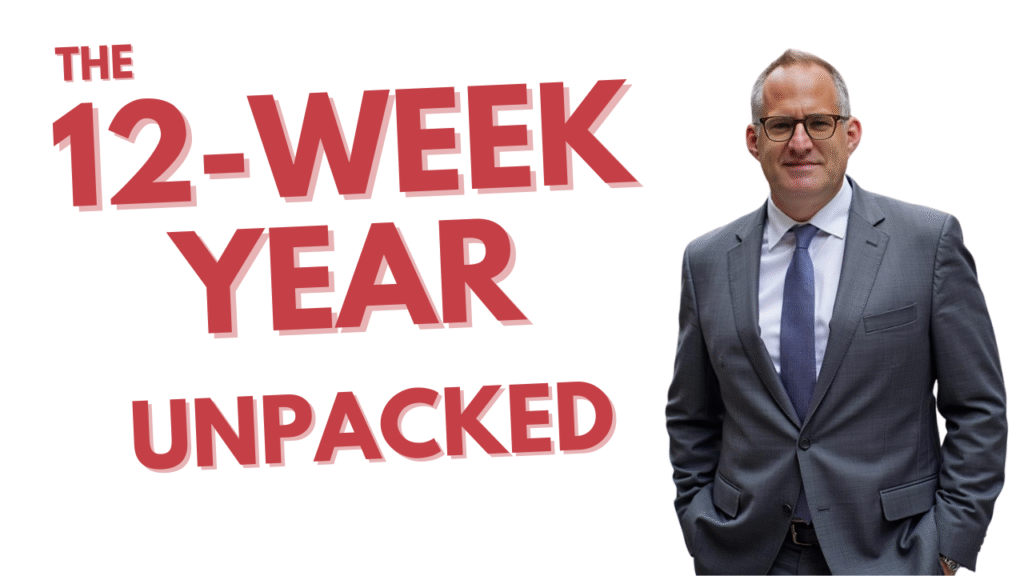
May 19th, 2025


If you feel like you’re stuck in a cycle of endless to-do lists and disappointing annual goals, you’re not alone. What if you could achieve more in just 12 weeks than most people accomplish in 12 months? That’s exactly what the 12-Week Year, developed by Brian Moran and Michael Lennington, promises.
In this post, we’ll dive deep into the 12-Week Year system, explain why it’s so effective, and give you actionable strategies to get more done in less time. Whether you’re a busy professional, entrepreneur, or just someone trying to reach big goals, this is the productivity framework that can transform your results.
Quickly about me: Creator of the 12-Week Breakthrough Program, world expert of the 12-Week system, helped dozens of ambitious individuals transform their lives by 5x-ing their productivity, 3x entrepreneur, Wharton MBA, MIT Data Scientist, worked in strategic consulting and venture capital at the highest levels.
The 12-Week Year is a revolutionary productivity system developed by Brian Moran and Michael Lennington. It challenges the traditional 12-month year approach by redefining a “year” to just 12 weeks. Instead of planning and executing goals over 12 months, you compress your planning and execution into 12-week cycles, creating urgency and focus.
In the book summary, Moran explains that this mindset shift leads to consistent execution, less procrastination, and results that outperform the typical year planning strategies.
The 12-Week Year has become a life-changing book for many professionals who are ready to achieve goals faster.
Traditional annual planning creates the illusion of ample time. This often leads to procrastination, inconsistent effort, and missed goals. Most people delay taking action until the final quarter of the year.
The 12-Week Year eliminates this risk by shortening the cycle. The shorter time frame demands focus, urgency, and clarity. You don’t have time to wait — you must act now.
As Brian Moran emphasizes, the key to success is not knowledge, but execution into 12-week cycles that drive results.
The 12-Week Year system is simple but powerful. It consists of a few critical components:
This systematic approach allows you to take big, long-term goals and break them down into actionable steps that can be achieved in 12 weeks.
When implemented correctly, users often see a performance boost by at least 4x, making it one of the most effective goal-setting frameworks available.
The power of the 12-Week Year lies in its ability to generate laser focus. By reducing the timeframe, you eliminate distractions and stay centered on what matters most.
This leads to:
Instead of spreading energy thin across many tasks, you execute on only the most important things—which is why so many people achieve more in less time using this method.

Start by crafting a vision that is bold, emotionally charged, and aligned with your values. Your vision should describe the life you want to lead in the next 2–5 years.
Then, define 12-week goals that serve as the bridge between your vision and your action plan. These goals should be measurable, actionable, and time-bound.
Example: “Enroll 30 new clients in my coaching program in 12 weeks” or “Publish 12 high-quality videos on the 12-Week Year.”
Once your goals are defined, you need an action plan. For each goal, list the critical weekly tasks that must be completed.
This step is essential to avoid the trap of vague intentions. A good 12-week plan includes:
This structure ensures your goals don’t remain dreams. They become achievable milestones.
Your weekly plan outlines what needs to happen each week. Break this into a daily plan to maximize your focus and prevent distractions.
By scheduling tasks that move the needle, you’re engaging in deep work. Each day becomes a stepping stone toward your bigger vision.
The beauty of the 12-week year is how it simplifies getting things done without overwhelm.
Accountability is crucial to success. While the 12-Week Year emphasizes self-accountability, having external support can amplify your results.
Set up:
People who implement the system with a coach or peer group are 10 times more likely to succeed, according to data from the12weekyear.com.
Tracking is essential for improvement. The 12-Week Year encourages you to use lead and lag indicators:
For example, if your goal is to increase revenue, your lead indicator might be the number of proposals sent weekly.
Use a simple scorecard: actions completed divided by actions planned. An 80% execution score is considered excellent.
Here are some actionable tips to help you succeed:
With the right mindset shift and tools, you’ll be amazed at what you can do in 12 weeks than others do in 12 months.
Ready to compress your planning and execution into 12-week sprints? Start now and transform your results.

Dan Mintz is the creator of the 12 Week Breakthrough Program. He advised dozens of individuals on how to achieve their most ambitious goals and reach their full potential.
Dan can be reached at:
dan.mintz@12week-breakthrough.com
About Dan Mintz
Additional Links:
Join the Program
Our Blog Page
Amazing Productivity Blogger
Social Links:
LinkedIn
X / Twitter
Instagram